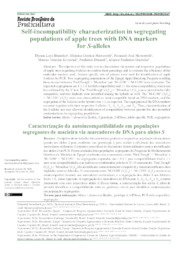Self-incompatibility characterization in segregating populations of apple trees with DNA markers for S-alleles.
Self-incompatibility characterization in segregating populations of apple trees with DNA markers for S-alleles.
Author(s): BRANCHER, T. L.; HAWERROTH, M. C.; HAWERROTH, F. J.; KVITSCHAL, M. V.; DENARDI, F.; GUIDOLIN, A. F.
Summary: Abstract - The objective of this study was to characterize the parents and respective populations of apple trees regarding S-alleles to confirm their genealogy and to evaluate the efficiency of the molecular markers used. Sixteen specific sets of primers were used for identification of apple S-alleles by PCR. Two segregating populations of the Epagri Apple Breeding Program resulting from crosses between ?Fred Hough? × ?Monalisa? and ?M-11/00? × ?M-13/91? were evaluated. The expected segregations are 1:1:1:1 for full compatibility and 1:1 for semi-compatibility, which can be confirmed by the X2 test. The ?Fred Hough? (S5 S19) × ?Monalisa? (S2 S10) cross proved to be fully compatible; and two triploids were identified among the hybrids as well. The ?M-11/00? (S3 S19) × ?M-13/91? (S3 S5 ) cross was characterized as semi-compatible based on DNA markers, and the segregation of the S-alleles in the hybrids was 1:1, as expected. The segregation of the DNA markers occurred together with their respective S-alleles: S2, S3 , S5 , S10, and S19. Thus, characterization of the S-alleles not only allowed identification of compatibility between parents but also identified contaminations in segregating populations. Index terms: Malus × domestica Borkh., S genotype, S-RNase, allele-specific PCR, segregation. Caracterização da autoincompatibilidade em populações segregantes de macieira via marcadores de DNA para alelos S Resumo - O objetivo deste trabalho foi caracterizar genitores e respectivas populações de macieiras quanto aos alelos S para confirmar sua genealogia e para avaliar a eficiência dos marcadores moleculares utilizados. Conjuntos específicos de iniciadores foram utilizados para a identificação dos alelos S via PCR. Foram avaliadas duas populações segregantes do Programa de Melhoramento Genético de Macieira da Epagri resultantes dos cruzamentos entre ?Fred Hough? × ?Monalisa? e ?M-11/00? × ?M-13/91?. As segregações esperadas são 1:1:1:1 para compatibilidade total e 1:1 para semi compatibilidade, que podem ser confirmadas pelo teste X2 . O cruzamento ?Fred Hough? (S5 S19) × ?Monalisa? (S2 S10) foi identificado como totalmente compatível, e foram identificados dois triploides entre os híbridos. O cruzamento entre ?M-11/00? (S3 S19) × ?M-13/91? (S3 S5 ) mostrou-se semicompatível baseado nos marcadores moleculares, e a segregação dos alelos S nos híbridos foi de 1:1, como esperado. A segregação dos marcadores de DNA para S2 , S3, S5, S10 e S19 ocorreujuntamente com seus respectivos alelos S. Dessa forma, a caracterização dos alelos S, além de permitir identificar a compatibilidade entre os genitores, serviu para identificar contaminações em populações segregantes. Termos para indexação: Malus × domestica Borkh., genótipo S, S-RNase, PCR alelo-específico, segregação. 1 Industrial biotechnologist, M.Sc. Doctoral
Publication year: 2021
Types of publication: Journal article
Unit: Embrapa Grape & Wine
Observation
Some of Embrapa's publications are published as ePub files. To read them, use or download one of the following free software options to your computer or mobile device. Android: Google Play Books; IOS: iBooks; Windows and Linux: Calibre.
Access other publications
Access the Agricultural Research Database (BDPA) to consult Embrapa's full library collection and records.
Visit Embrapa Bookstore to purchase books and other publications sold by Embrapa.

